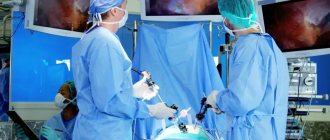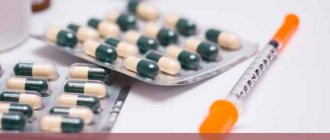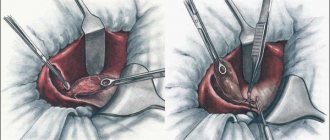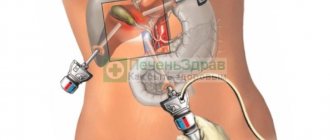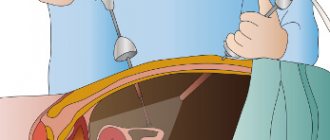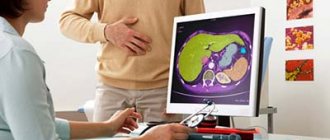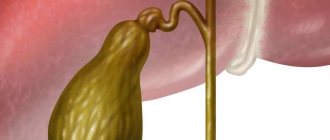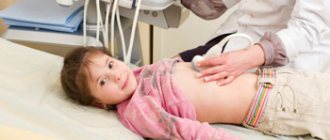Pathologies of the biliary system occupy third place among diseases of the digestive tract. If long-term conservative treatment is ineffective, then removal of the gallbladder (cholecystectomy) is prescribed. In most cases, the operation leads to a complete cure, so discomfort and pain disappear. But for this, the patient has to follow a special diet. It is worth considering in more detail whether to remove the gallbladder, how the operation is performed, what indications and contraindications it has.
Rehabilitation and recovery in the postoperative period
After removal of the gallbladder, the first thing the patient feels is pain in the right hypochondrium. This is fine. Each operation involves a violation of the integrity of the soft tissues of the body; pain is a protective reaction to damage.
Non-narcotic or narcotic analgesics are prescribed to treat pain. The choice of drug depends on the severity of pain and the time that has passed since the operation.
In the early postoperative period, narcotic analgesics are prescribed - Promedol, Fentanyl.
In the late postoperative period (after 2-3 days), the patient is transferred to non-steroidal anti-inflammatory drugs with a pronounced analgesic effect - Ibuprofen, Indomethacin. An alternative to these medications are myotropic antispasmodics (No-shpa, Papaverine), which also effectively relieve pain. These drugs are combined with each other, which gives a pronounced analgesic effect.
Caring for a patient after gallbladder removal
If the gallbladder was removed laparoscopically, the patient does not require special care. Due to the fact that the patient feels nausea on the first day, he is not given food for 24 hours, after which he is given a trial breakfast. You can start giving regular water to drink 6-8 hours after the operation is completed. You can become more active and start walking after 5-6 hours; discharge from the hospital occurs 2-5 days after removal of the gallbladder.
If the gallbladder was removed by an open (laparotomy) method, then the patient will need care for the first 2-3 days. For the first 24 hours, it is forbidden to get out of bed, so a caregiver must be nearby. Drinking is allowed after 12-24 hours, the first meal - for 2-3 days. Nutrition begins with liquid broths or mucus soups without salt and spices. Early activation (3-4 days after removal of the gallbladder) is the key to quick recovery. Discharge from the hospital occurs after a week or 10 days.
Throughout the postoperative period the following is carried out:
- Prevention and treatment of infectious complications by administering antibiotics.
- Prevention of hypovolemia. To do this, the patient is given large quantities of infusion solutions and blood substitutes.
- Body temperature is measured daily in the armpits. An increase in body temperature is the first sign of an ongoing infectious process.
- Monitor nutrition and diet compliance.
Why are stones dangerous?
As long as the stones are in the cavity of the gallbladder, a person may not even be aware of their presence. As soon as the accumulations begin to move along the bile ducts, a person is overcome by attacks of biliary colic, lasting from several minutes to 8-10 hours, dyspeptic disorders appear (difficult and painful digestion, accompanied by pain in the epigastric region, a feeling of fullness of the stomach, nausea and vomiting, heaviness in the stomach). right hypochondrium).
Choledocholithiasis (stones in the bile duct) pose a danger due to the possible development of inflammation of the ducts, pancreatitis, and obstructive jaundice. Often, large accumulations of stones during movement cause other dangerous complications:
- perforation – rupture of the gallbladder or ducts;
- peritonitis - inflammation of the peritoneum resulting from the effusion of bile into its cavity.
Long-term stagnation of bile can lead to the appearance of polyps on the walls of the organ and their malignancy (malignancy). Acute cholecystitis with the presence of stones is a reason for urgent hospitalization and surgical treatment, but even the asymptomatic course of the pathology does not exclude the possibility of surgery if the following indications are present:
- risk of developing hemolytic anemia;
- a sedentary lifestyle to avoid bedsores in bedridden patients;
- jaundice;
- cholangitis - inflammation of the intrahepatic or bile ducts;
- cholesterosis – metabolic disorder and accumulation of cholesterol on the walls of the gallbladder;
- calcification – accumulation of calcium salts on the walls of an organ.
Indications for gallbladder removal
Initially, the stones formed in the bowels of the gallbladder are small in size: from 0.1 to 0.3 mm. They may go away on their own with physical therapy or medication. If these methods are ineffective, the size of the stones increases over time (some stones can reach 5 cm in diameter). They are no longer able to painlessly pass through the bile ducts, so doctors prefer to resort to removing the organ. Other indications for prescribing the procedure are:
- the presence of sharp stones that increase the risk of perforation of the organ or its parts;
- obstructive jaundice;
- acute clinical symptoms - severe pain, fever, diarrhea, vomiting;
- narrowing of the bile ducts;
- anomalies of the anatomical structure of the organ;
- patient's wishes.
Contraindications
There are general and local contraindications to cholecystectomy. If emergency surgical intervention is necessary due to a threat to human life, some of them are considered relative and may not be taken into account by the surgeon, since the benefits of treatment outweigh the possible risks. General contraindications include:
- acute myocardial infarction - damage to the heart muscle caused by circulatory disorders due to thrombosis (blockage) of one of the arteries;
- stroke - acute cerebrovascular accident;
- hemophilia – a blood clotting disorder;
- peritonitis – inflammation of a large area of the abdominal cavity;
- obesity 3 and 4 degrees;
- presence of a pacemaker;
- gallbladder cancer;
- malignant tumors on other organs;
- other diseases of internal organs in the stage of decompensation;
- late pregnancy.
Local contraindications are relative and may not be taken into account under certain circumstances. Such restrictions include:
- inflammation of the bile duct;
- peptic ulcer of the duodenum or stomach;
- cirrhosis of the liver;
- gallbladder atrophy;
- acute pancreatitis - inflammation of the pancreas;
- jaundice;
- adhesive disease;
- calcification of organ walls;
- large hernia;
- pregnancy (1st and 2nd trimester);
- abscess in the biliary tract;
- acute gangrenous or perforated cholecystitis;
- history of surgical intervention on the abdominal organs, performed via laparotomy.
Drug treatment and rehabilitation after gallbladder removal at home
After discharge from the hospital, the patient must follow all recommendations of the attending physician. The following general requirements are imposed on the patient:
- Treat postoperative sutures daily to avoid infection on the skin.
- For patients whose gallbladder has been removed openly, doctors recommend wearing a bandage for the first time to reduce the load on the abdominal muscles.
- Carry out pain relief and enzyme replacement therapy with prescribed medications.
- Adjust your diet and follow a postoperative diet in accordance with general recommendations.
- Limit physical activity for the next three months, but there is no need to limit your usual habitual physical activity. Light exercises and daily walks are not prohibited and are even necessary for normal recovery.
When surgery is not performed
There are absolute and relative contraindications to surgery:
- bile duct abscess;
- purulent inflammation of the bladder;
- exacerbation of pancreatitis;
- pathologies of the cardiovascular system;
- obstructive jaundice;
- tumors in the gallbladder;
- last trimester of pregnancy;
- fistulas between the duodenum and bile ducts;
- gangrenous cholecystitis;
- blood incoagulability;
- pacemaker in the heart.
To prevent negative consequences and determine contraindications, you need to undergo laboratory and instrumental examinations before surgery.
Medicines to be taken at home
Pain relief
If after discharge he continues to experience excruciating pain in the right hypochondrium, then he continues to take analgesics. The following medications are suitable for home pain relief:
- Indomethacin is one of the very first drugs in this group used for pain relief. Indomethacin is taken in tablets of 25 mg 2-3 times a day.
- Ibuprofen, Ibufen is a powerful analgesic of the latest generation that has a pronounced anti-inflammatory effect. The medicine is taken in tablets of 1.2 g per day in 3 divided doses.
- Ketanov is one of the most powerful analgesic drugs. It is effective for relieving attacks of pain, but continuous use of this drug is not recommended. If pain suddenly overtakes you, one tablet is enough for relief. At one time - no more than two tablets.
Treatment of enzyme deficiency
To improve digestion function and normalize the functioning of the gastrointestinal tract, taking enzyme preparations is indicated. These medications contain substances that replace the deficiency of their own enzymes (previously produced by the gallbladder). As a result, digestive functions are fully restored, and disorders (diarrhea, diarrhea, flatulence and bloating) are not a concern. Enzyme therapy is indicated for all patients who have undergone gallbladder removal.
The following enzyme drugs are applicable:
- Pancreatin – 1 tablet for each meal.
- Creon 1000 (2500) is the latest generation drug that is best adapted to the human gastrointestinal tract. Creon take 1 capsule 10-15 minutes before meals.
- Panzinorm is a multienzyme drug, the dose of which is selected individually by the attending physician.
Bile acid preparations – Festal. Festal is a combination drug that contains bile acids and digestive enzymes. After removal of the gallbladder, this drug can be used as monotherapy to treat digestive disorders. Festal is prescribed 1-2 tablets with meals, washed down with plenty of liquid.
Important! Another drug that is prescribed in the postoperative period is Ursofalk or Ursosan. They contain substances that improve the rheological properties of bile, preventing the formation of new stones. This is how the disease relapses are prevented.
Indications and contraindications
Not all patients suffering from pyriform organ dysfunction can undergo laparoscopy. The reason is the presence of medical contraindications.
In what cases do surgeons accurately refer a patient for cholecystectomy? In the presence of:
- Polyps in the gallbladder area.
- Cholecystolithiasis (presence of stones).
- Calculous cholecystitis.
- Cholesterosis.
There are many contraindications for this type of surgical intervention. Let's list them:
- Cicatricial changes in the tissue surface of the liver or stomach.
- Abscess of the pyriform process.
- Pregnancy (3rd trimester).
- Pancreatitis (acute form).
- Anatomical pathology of the location of the abdominal organs.
- Presence of a pacemaker in the body.
- Heart failure.
- Diseases of the respiratory system.
- Impaired blood clotting.
- Acute cholecystitis.
- Intrahepatic position of the pyriform process, etc.
Traditional methods of treatment
Along with drug treatment, folk methods are also used. For this purpose, herbal decoctions, teas, and tinctures are prepared. They are used to prevent stone formation and improve the flow of bile.
To do this, use a decoction of the fruits of Rosehip or Milk Thistle. The fruits are ground, poured with 1 liter of water and boiled over low heat. After the broth has cooled, strain it. Drink 1 tablespoon of the decoction every hour. The course of treatment is 2-3 weeks.
Infusions are prepared from leaves or buds of young birch, corn silk, and oak bark. To do this, pour boiling water over them and leave them in a dark place for 2-3 hours or overnight. Drink 1 teaspoon of infusion every hour.
Diet after gallbladder removal
The diet is followed from the first days after removal of the gallbladder. On the first day, you are only allowed to drink mineral alkaline water like Borjomi. Further, food with a puree-like consistency is allowed: grain porridge with water, mucus soups, jelly.
After discharge from the hospital, the main task of rehabilitation is to consistently transfer the patient from gentle nutrition to an extended diet.
In the first month after surgery, the diet includes the following foods:
- Rye and wheat crackers, stale bread.
- Lean meats.
- Cereal porridge with milk or water.
- Cereals: buckwheat, rice, corn, semolina.
- Pasta made from durum wheat.
- Low-fat types of fish.
- Fermented milk products (kefir, bifidok, fermented baked milk, cottage cheese).
- Fruit and berry juices, compotes, jelly.
- Green or black tea.
Spicy, fried and fatty foods, alcoholic and alcoholic drinks, and smoking are strictly limited. Food is steamed or boiled. It is recommended to eat small portions, but often, so as not to overeat.
Vegetables and other non-irritating foods are gradually introduced from the second month after gallbladder removal. This is necessary to prevent digestive disorders. At this time, they monitor food tolerance and the body’s reaction to new food. If a food product is poorly tolerated, it is excluded from the diet completely.
Important! Spicy, fatty, fried foods, alcohol and smoking are excluded forever after removal of the gallbladder. Pickled snacks and pickles are also harmful. To avoid mistakes, adhere to the principle: all my food should be neutral in taste and not cause discomfort in the stomach.
Preparation for the procedure
In the vast majority of cases, gallstone laparoscopy is a planned intervention. In order to identify possible contraindications and the general condition of the body in advance, 14 days before the procedure the patient undergoes an examination and submits a list of tests:
- physical examination by a surgeon;
- visiting a dentist, therapist;
- general analysis of urine and blood;
- blood biochemistry with the establishment of a number of indicators (bilirubin, sugar, total and C-reactive protein, alkaline phosphatase);
- establishing the exact blood type, Rh factor;
- blood for HIV and Wasserman reaction, hepatitis viruses;
- hemostasiogram identifying activated partial thromboplastin time, thrombosed time and index, fibrinogen;
- fluorography;
- Ultrasound;
- retrograde cholangiopancreatography;
- electrocardiography;
- for women - vaginal smear for microflora.
An operation to remove the gallbladder using the laparoscopic method will be carried out only if the results of the above tests correspond to the norm. If there are deviations, the patient will need to undergo a course of treatment to eliminate the identified violations. If the patient has pathologies of the respiratory and digestive systems, in consultation with the operating doctor, a course of drug therapy is possible to eliminate negative symptoms and stabilize the condition.
Preparation for laparoscopy of the gallbladder in the inpatient department includes a number of sequential activities:
- on the eve of surgery, the patient’s diet should consist of easily digestible food, the last meal is dinner at 19-00, after which you cannot take any food; after 22-00 it is forbidden to drink liquids, including water;
- on the day when the operation is scheduled, eating food and liquid is prohibited;
- in order to cleanse the intestines, it is necessary to do cleansing enemas - the evening before the intervention and in the morning; for greater effectiveness, it is possible to take laxatives 24 hours before surgery;
- In the morning you need to carry out hygiene procedures - take a shower, use a razor to remove hair on your stomach.
On the eve of the operation, doctors - a surgeon and an anesthesiologist - have a conversation with the patient, during which they talk about the upcoming intervention, anesthesia, possible risks and negative consequences. The conversation is conducted in a consultation form - the patient can ask questions of interest. Afterwards, the patient gives written consent to the intervention and the use of anesthesia.
Lifestyle and care for patients after gallbladder removal
Patients after removal of the gallbladder do not require special care. The patient must independently monitor the intake of recommended medications and follow a diet throughout his life in order to develop new eating behavior. In the first six months, the entire schedule is set so that the person does not miss another meal. This is done so that in the next hours of taking it he does not overeat and does not put a large load on the biliary system. After six months, most patients return to their normal lifestyle.
During the recovery period, to complete the treatment, rest in a sanatorium, take daily walks in the fresh air, and do light exercises in the morning. If your job involves heavy physical labor, change it and return to it only after the permission of your doctor.
Complications in the form of concomitant diseases of the digestive system worsen the prognosis. In this case, complete recovery may not occur due to concomitant aggravating pathology. Such a patient is observed throughout his life by a gastroenterologist or general practitioner at his place of residence. Therapy, daily routine, and diet for such patients are selected by the doctor individually according to the severity of the gastrointestinal tract diseases.
Preparatory measures
So, you have received a referral for laparoscopy. But before you have it, you need to prepare for the operation.
Basic preparatory preoperative measures:
- Don't overeat the day before surgery. The food you eat on this day should be light and easily digestible by the stomach. The last meal is until 19.00.
- Before going to the operating table, you will have 2 enemas. One - the day before laparoscopy, and the second - in the morning. The main goal of this procedure is to cleanse your body. To achieve maximum cleansing effect, it is recommended to use the drug Normacol.
- Before cholecystectomy you need to take a shower. It is advisable to wash with soap.
- It is necessary to take Espumisan the day before surgery (recommended for some medical indications).
But that is not all. On the day of your laparoscopy, avoid eating. It is not advisable to even drink water.
It is also prohibited to take any medications other than those prescribed by the doctor. Why is it important?
Taking certain medications can impair blood clotting, which will create an obstacle to surgery.
Important! In some individual cases, the doctor will prescribe the patient preoperative treatment for concomitant pathology.
